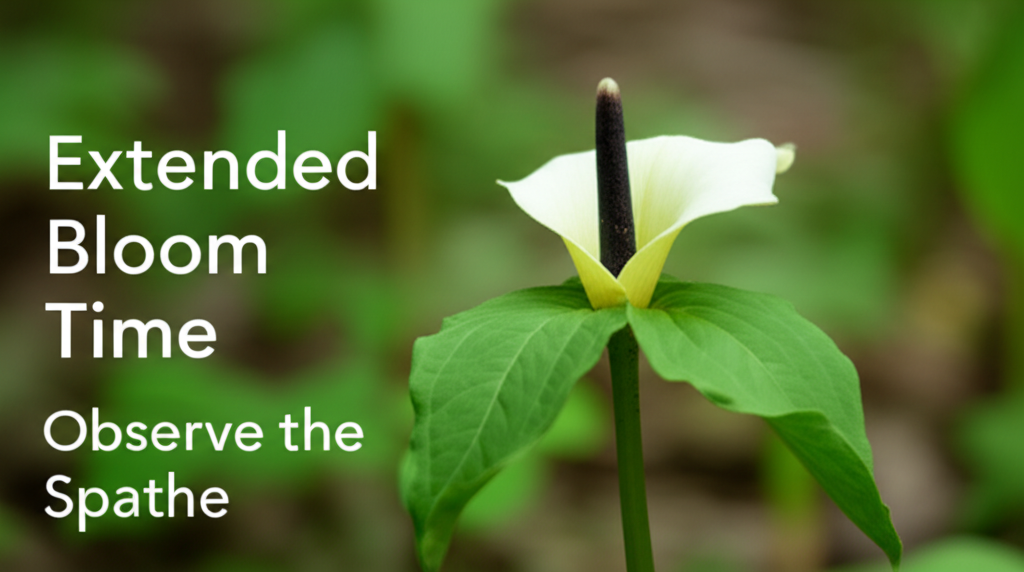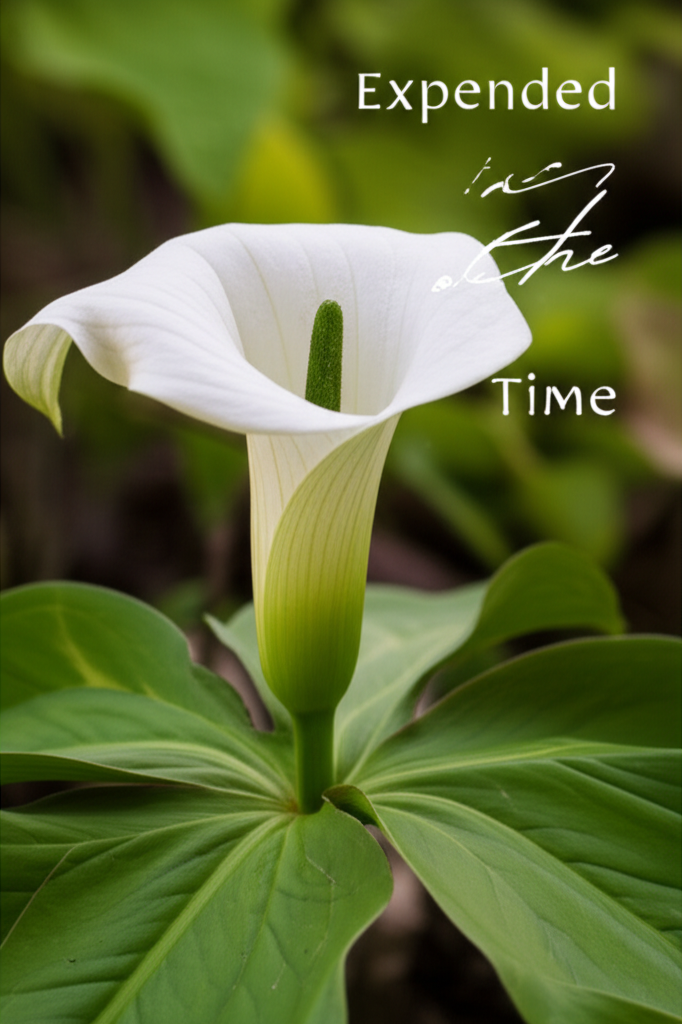Unveiling the Enigmatic Jack-in-the-Pulpit: Beyond the Bloom
The Jack-in-the-Pulpit, Arisaema triphyllum, is a botanical marvel that captivates gardeners and nature enthusiasts alike. Its unique structure, resembling a preacher standing at a pulpit, is instantly recognizable and evokes a sense of woodland wonder. While its distinctive “flower” is short-lived, understanding its life cycle and exploring ways to potentially extend the observation period offers a deeper appreciation for this fascinating native plant. This article delves into the nuances of the Jack-in-the-Pulpit’s flowering season, its intricate biology, and practical advice for maximizing your enjoyment and observation of this woodland gem.
The Biology of the “Flower”
It’s crucial to clarify that what we commonly refer to as the Jack-in-the-Pulpit’s “flower” is actually an inflorescence, a cluster of small, true flowers. This inflorescence is enclosed within a spathe (the “pulpit”) and topped by a spadix (the “jack”). The spathe, often green with purple veins, curves over to form a hood, protecting the reproductive parts within. The spadix, a fleshy spike, emerges from the spathe and can vary in length and color.
The true flowers are found at the base of the spadix, hidden within the spathe. They are typically unisexual, with male and female flowers on separate plants or sometimes on the same plant in different arrangements. Pollination is a marvel in itself, often facilitated by tiny insects like gnats and midges, which are lured into the spathe by scent and trapped by downward-pointing hairs. Once pollination occurs, the spathe begins to wither, and the distinctive cluster of berries develops.
Understanding the Natural Flowering Season
The Jack-in-the-Pulpit’s natural flowering period is relatively brief, typically occurring in late spring to early summer. In most temperate North American regions, this translates to roughly late April through June. However, several factors can influence the exact timing and duration:
- Geographic Location: Plants in warmer southern climates will bloom earlier than those in cooler northern regions.
- Microclimate: Shaded, moist woodland floors, the Jack-in-the-Pulpit’s preferred habitat, often retain moisture and cooler temperatures, which can slightly delay blooming compared to more exposed or sunnier areas.
- Seasonal Weather: A particularly warm spring can accelerate blooming, while a cold, wet spring might delay it.
- Plant Age and Vigor: Mature, healthy plants are more likely to produce a robust inflorescence.
The ephemeral nature of the spathe and spadix means that once they have served their purpose of attracting pollinators and facilitating fertilization, they begin to senesce. This means the visual spectacle of the “pulpit” is fleeting, making timely observation essential for those wishing to witness it in its prime.
Strategies for Extending Observation of the Jack-in-the-Pulpit

While you cannot fundamentally alter the plant’s biological timeline to create a prolonged bloom, you can employ strategies to extend your observation period and maximize your chances of experiencing the plant in its various fascinating stages. This involves understanding its habitat, observing diligently, and appreciating the plant beyond its initial flowering.
1. Cultivating and Site Selection for Optimal Viewing
Growing Jack-in-the-Pulpit in your own garden offers the most control over observation. Key considerations for successful cultivation and extended viewing include:
- Habitat Mimicry: Replicate its natural woodland environment. This means providing:
Partial to Full Shade: Dappled sunlight filtering through trees is ideal. Avoid direct, scorching sun.
Moist, Well-Drained Soil: Rich, organic soil with good drainage is crucial. Amend heavy clay with compost and leaf mold.
Protection from Wind: Strong winds can damage the delicate spathe.
- Planting Location: Choose a spot where you can easily access and observe the plants throughout the growing season. Consider planting them in groups for a greater visual impact.
- Companion Planting: Integrating Jack-in-the-Pulpit with other shade-loving native plants can create a more immersive woodland experience and extend the season of interest in that garden area. Think ferns, hostas (native varieties), trilliums, and woodland wildflowers.
2. Diligent Observation Throughout the Season
The “flowering” stage is just one part of the Jack-in-the-Pulpit’s journey. To extend your observation, shift your focus to its other developmental phases:
- Early Emergence: The tightly furled spathe emerging from the soil in early spring is a sign of life and anticipation.
- Unfurling Spathe: Witnessing the spathe slowly unfurl to reveal the spadix is a subtle but rewarding experience.
- Post-Flowering Transformation: After the “flower” has faded, the plant produces a cluster of bright red berries in late summer and fall. These berries are a vibrant addition to the woodland garden and are a food source for birds.
- Dormancy: Even in its dormant state, the plant’s presence is marked by its fallen leaves and the promise of its return.
3. Understanding Variations and “Flowering” Stages
Jack-in-the-Pulpit exhibits interesting variations that can contribute to extended observation:
- Male vs. Female Plants: While both produce the characteristic spathe and spadix, their “flowering” might appear slightly different in subtle ways, particularly in the arrangement of the spadix. Observing multiple plants can highlight these differences.
- “False” Flowers (Spadix Appendages): Some species and even individual plants within Arisaema triphyllum can have various structures on the spadix, including elongated or club-like appendages. These variations offer further points of interest for keen observers.
- Reversion to Male: It’s fascinating to note that Jack-in-the-Pulpit plants can change their sex over their lifetime. A plant that flowers as female one year might flower as male the next, depending on its size and energy reserves. This provides a dynamic element to long-term observation.
4. Documenting Your Observations
To truly extend your appreciation, actively document your encounters:
- Photography: Take photos of the plant at different stages of its development – from emergence to berry production. This creates a visual timeline of its seasonal cycle.
- Journaling: Note down dates of emergence, flowering, berry development, and any unusual observations. Record environmental conditions like temperature and rainfall.
- Sketching: For a more artistic approach, sketch the plant, paying attention to its form and details.
Key Facts and Comparison Table
To summarize the key characteristics and aid in identification and appreciation, here’s a table of important facts about the Jack-in-the-Pulpit:
| Feature | Description | Significance for Observation |
|---|---|---|
| Botanical Name | Arisaema triphyllum | Accurate identification is the first step to observation. |
| Common Names | Jack-in-the-Pulpit, Indian Turnip, Bog Onion | Understanding local common names can aid in finding and discussing the plant. |
| Family | Araceae (Arum family) | Places it within a broader botanical context, with other plants sharing similar inflorescence structures. |
| Native Range | Eastern North America | Important for conservation and understanding its ecological role. |
| Habitat | Moist, shaded woodlands, swamps, streambanks | Guides successful cultivation and where to observe wild specimens. |
| “Flower” Structure | Spathe (hooded leaf) enclosing spadix (fleshy spike) with true flowers at its base. | The primary visual attraction, whose ephemeral nature defines the “flowering season.” |
| Flowering Season | Late April to June (variable) | The core period for observing the inflorescence. |
| Pollination | Insect-mediated (gnats, midges) | A hidden, fascinating aspect of its reproductive cycle. |
| Fruit | Cluster of bright red berries | Provides a significant visual interest in late summer/fall, extending observation. |
| Toxicity | Contains calcium oxalate crystals; all parts are toxic if ingested raw. | Important for safety, especially with children and pets. |
Comparing Arisaema Species
While Arisaema triphyllum is the most common, several other Arisaema species exist, offering varied characteristics and potentially slightly different observation periods. Understanding these differences can enhance your appreciation for the genus as a whole.
| Species | Key Distinguishing Features | Geographic Distribution (Primary) | Typical “Flowering” Season (Relative) |
|---|---|---|---|
| Arisaema triphyllum | 3 leaflets, spathe often green with purplish veins, hooded. | Eastern North America | Late Spring (April-June) |
| Arisaema dracontium (Green Dragon) | Single, palmately compound leaf with 5-15 leaflets. Spathe is green and narrow, spadix extends significantly beyond the spathe. | Eastern and Central North America | Late Spring to Early Summer (May-July) |
| Arisaema quinatum | 5-7 leaflets, often larger than triphyllum. Spathe usually more consistently purple-striped. | Southeastern United States | Spring (April-May) |
| Arisaema stewartianum | Distinctive mottled spathe patterns, often with a long, whip-like appendage on the spadix. | Himalayan region | Varies by climate, typically late spring. |
Note: “Flowering Season” is relative and can be influenced by local climate and microhabitat.*
Maximizing Your Observation Experience: Practical Steps and Considerations
To truly savor the Jack-in-the-Pulpit and extend your observation window, follow these practical steps and consider these important points:
Steps to Enhance Observation
- Identify a suitable habitat: Locate natural woodlands or create a woodland-like environment in your garden with the correct light, moisture, and soil conditions.
- Plant or locate specimens: Either cultivate your own Jack-in-the-Pulpit from seed, divisions, or nursery plants, or identify existing wild populations.
- Begin observation in early spring: Look for the first signs of emergence – the tightly coiled spathe pushing through the leaf litter.
- Monitor daily/weekly: As the plant grows, observe the unfurling of the spathe and the development of the spadix. Note the colors and patterns.
- Observe pollination (if possible): While challenging due to its hidden nature, be aware of insect activity around the plant during its flowering phase.
- Continue observation post-flowering: The spathe will wither, but the plant remains vibrant with its developing cluster of berries, which are often a striking red.
- Note seasonal changes: Observe when the leaves begin to yellow and die back, signaling the plant’s transition to dormancy.
- Document your findings: Use photography, journaling, or sketching to record the plant’s progression throughout the year.
Pros and Cons of Extended Observation Strategies
| Strategy | Pros | Cons |
| :——————- | :————————————————————————————————– | :——————————————————————————————————- |
| Cultivation | High degree of control over environment, guaranteed access, ability to experiment with growing conditions. | Requires effort, resources, and knowledge of plant care. May not perfectly replicate wild conditions. |
| Habitat Preservation | Supports wild populations, allows for observation in natural settings. | Limited control, dependent on natural cycles, potential for disturbance or over-collection. |
| Focus on Life Cycle | Deepens understanding of the plant’s biology and ecological role, extends appreciation beyond bloom. | Requires a shift in perspective; less visually dramatic than the initial “flowering” stage. |
| Documentation | Creates a personal record, enhances attention to detail, aids in scientific understanding. | Time-consuming; requires commitment to regular observation and recording. |
| Understanding Variations | Enhances appreciation for the diversity within the species and genus. | May require more advanced botanical knowledge; subtle differences can be hard to discern initially. |
Beyond the Bloom: The Enduring Appeal of Jack-in-the-Pulpit
The Jack-in-the-Pulpit’s allure extends far beyond its fleeting “flowering” period. Its unique form, its intriguing reproductive strategy, and its vital role in woodland ecosystems make it a subject of continuous fascination. By understanding its biology and employing thoughtful observation strategies, you can extend your appreciation for this woodland icon throughout its entire life cycle, from its first tender shoots in spring to its slumbering roots in winter.
Whether you choose to cultivate it in your own garden or seek it out in its native habitat, the Jack-in-the-Pulpit offers a rewarding experience for anyone who takes the time to truly look. Its presence signifies a healthy woodland, a testament to the intricate beauty and resilience of nature. Embrace the extended observation, and you’ll discover a deeper connection to this remarkable native plant.


